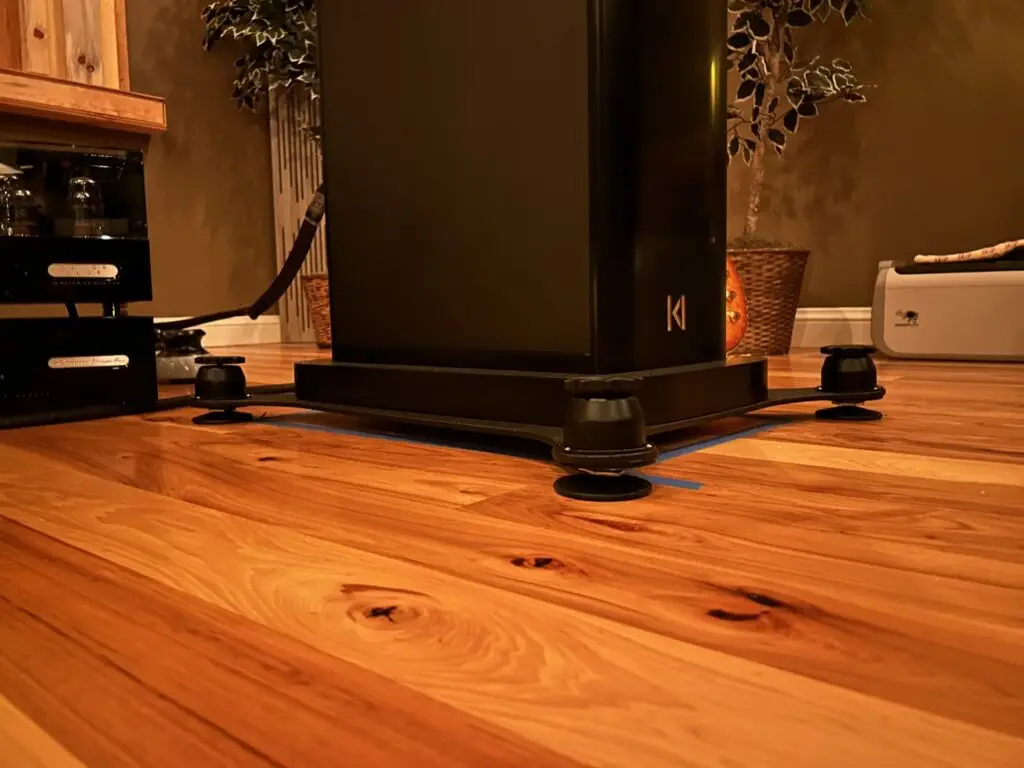I’ve been fascinated with the importance of vibration control for more than three decades now. A lot of my experience is already covered in Millercarbon’s Mega Vibration Control Journey https://forum.audiogon.com/discussions/millercarbon-s-mega-vibration-control-journey The Journey ended with springs. Then I got Pods, and wrote Vibration Control and the Townshend Audio Seismic Pods https://forum.audiogon.com/discussions/vibration-control-and-the-townshend-audio-seismic-pods Now as we continue our journey forward it is time to review the Townshend Audio Podiums.
Podiums are based on the same basic engineering used in Pods. A spring is encased in a rubber sleeve that functions as a sort of bellows, trapping the air inside. At the top the spring is attached to a threaded metal plate with a single very precise small hole in it. The threads are for height adjustment and the hole is to allow air to pass through. A very small, precision-controlled amount of air. This tiny little hole allows the air to function as a damper.
A fundamental challenge with springs is they bounce. We want them to bounce. But we do not want them to keep bouncing! When that happens we say it resonates, and resonance adds color. It is a form of distortion, and we don’t want it. Springs all by themselves are already very good at isolation. Please read the above threads to see just how good they are. But even as good as they are springs do have this problem of resonance.
The problem with damping is figuring out how to achieve it, and how much to use? The air valve method Max Townshend invented uses only a couple percent damping ratio and does this with air alone and no moving parts. Genius!
The four damped spring towers are attached to a very dense, massive and inert plinth. My traditional knuckle rap test yielded a very satisfactory ’thunk’. Stiff and highly damped, it is also covered in an extremely durable and beautiful finish. Sliding speakers on and off left zero marks on them, and they really are handsome to look at.
The damped spring towers at each corner are threaded for two different leveling adjustments. The first is to level the unloaded Podium on the floor. This first step eliminates any problems or situations where the floor is not perfectly level. This adjustment (if necessary) is made with a special thin wrench that comes supplied with the Podiums.
The speakers are then placed on the Podiums and fine tuned for precision placement. At this point, loaded with 150lbs worth of Moabs, making fine positioning adjustments on my thick carpet proved a bit of a challenge. The solution I came up with was BDR Round Things under the footers. Furniture gliders would probably also work. If it is even a problem. My carpet and pad are very thick. They do look like they will work beautifully on hardwood flooring.
Once perfectly positioned the speakers are raised by turning the knobs at each corner. There is a process to doing this. First all four are turned equally, until all four corners are floating free and clear. It is essential to allow freedom of motion in all planes. Once this is achieved then the speakers can be adjusted perfectly level by turning the knobs in pairs- the two on the left or right, or the two on the front or back. Adjusting in pairs this way avoids diagonal rocking.
Describing this process in print is hard but doing it in practice is easy. In fact this was the coolest part of setting them up! With the Podiums I was able to place my level right on the Podium. Even fully loaded with about 150lbs of Moabs and BDR the knobs turn silky smooth, and precision leveling is super easy.
Okay, okay, so how do they sound? In a word: wonderful! This can’t come as much of a surprise. They are after all basically Pods attached to a plinth, and the Pods work wonderfully under everything I have tried. Still, the Podiums are pretty impressive.
The first thing I noticed was improvement in the direction of what I would call a more natural sound. Natural sounds are almost never described as having glare or strain. Natural sounds can be quite loud. But there is a difference in nature between a loud natural sound and the same sound through a system. They may measure the same volume but we have no trouble hearing the difference.
At this point I have to agree with Max and say that the difference is ringing. Natural sounds start and stop very quickly. Sounds reproduced by our systems cause the system itself to vibrate, then the room, and the room feeds back into the system until the whole thing is ringing like a bell. This all happens very fast and can be seen demonstrated on a seismograph placed on a speaker. https://youtu.be/BOPXJDdwtk4?t=6
In any case, whatever the explanation it is clear there is a lot less glare and strain with speakers on the Townshend Podiums. This results for me in a lot less listener fatigue. Another thing I find is that while I don’t necessarily need to turn the volume up, when I do it is way more enjoyable! The combination of speakers like Moabs capable of playing very loud and strain-free with Podiums is intoxicating!
The next thing I’m hearing is a massive improvement in what I would call truth of timbre, or tone, or whatever you want to call it that makes each individual instrument sound more like itself and not any other. Not the big differences that distinguish a steel from a string guitar, but the little details that distinguish one wood-bodied gut-stringed guitar from another. Not hyped-up count the spittle hitting the mic details either but the sort of tonal shadings that distinguish the real vocal talent from the second-tier. Even now after more than a month on Podiums still I put on records that have me going Wow that wood block really is a wood block!
This is why I spent so much time explaining Max’s damping mechanism. Before Podiums my Moabs were on springs. The load was the same, and the springs were properly sized for the load. However, the springs on my DIY platforms were not damped. Consequently, they had their characteristic resonance. This resonance colors everything played on them. Like viewing the world through rose-colored glasses- you may like what you see but that ain’t the world! Now on Podiums the world as presented by the Moabs is full blown Ultra Panavision 70! https://vashivisuals.com/the-hateful-eight-ultra-panavision-70/
Those who follow me know I am not just about sound quality, I am also about value. Because I am so passionate about sound quality, but have only limited resources, I have to be. No way I have enough money to go chasing the latest and greatest. One look at my system anyone can see how hard I will work if it will get the job done for less. https://systems.audiogon.com/systems/8367
For sure springs will do a very fine job for very low cost. Just about any spring, properly tuned and used, will outperform an awful lot of stuff that costs a whole lot more. For sure anyone in the market for good vibration control solutions- and that should be everyone! – should consider springs. But Townshend Podiums are so much better than ordinary springs that I have to say that even at their price they are not just as good value, but even better. They are that good.

